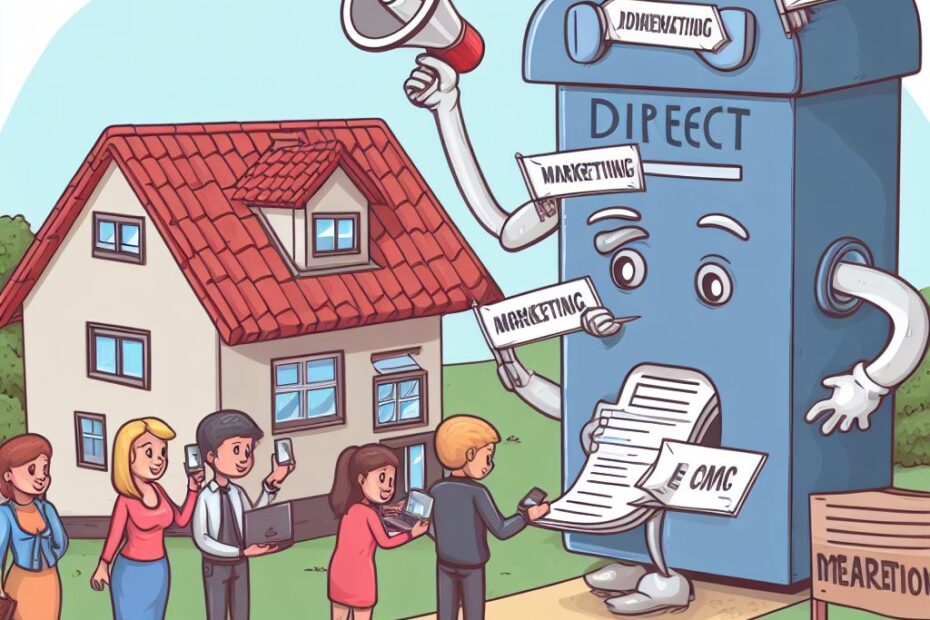In the ever-evolving world of business, direct marketing for small businesses has emerged as a powerful strategy for small businesses to reach out to their potential customers. Direct marketing focuses on targeted, measurable communication with consumers. It allows small businesses to engage with their audience on a personal level, delivering tailored messages to promote their products or services directly. This article aims to provide a comprehensive guide on how to effectively implement direct marketing strategies for small businesses.
Direct marketing is an advertising method in which businesses establish one-to-one communication with their customers through various channels, encompassing traditional mail, electronic mail, telephone, and face-to-face interactions. The primary objective of direct marketing is to stimulate a particular customer action, such as making a purchase, filling out a form, or subscribing to a newsletter.
This type of marketing is designed to prompt immediate responses and build lasting, customer-focused relationships. It’s a strategic approach that allows businesses to personalize their messages and measure responses directly. Whether it’s prompting a customer to make a purchase, complete a survey, or sign up for a subscription, direct marketing aims to incite a reaction.
By leveraging various channels, businesses can reach customers directly and personally, tailoring their marketing messages to specific consumer preferences and needs. This approach allows for the creation of targeted campaigns that resonate on a personal level, thereby increasing the likelihood of eliciting the desired response.

Importance of Direct Marketing for Small Businesses
1 – Targeted Marketing:
The power of direct marketing lies in its ability to reach a specific set of customers with messages that are tailored to their needs and interests. This approach not only resonates with the target audience but also enhances the likelihood of conversions.
The key to successful targeted marketing is understanding your audience and their unique needs. As the renowned consultant Peter F. Drucker explained, “The aim of marketing is to know and understand the customer so well the product or service fits him and sells itself”.
This understanding allows businesses to craft messages that cut through the noise and address the specific needs and desires of their customers. The result? Products and services that truly meet the demands of your audience, and marketing campaigns that are effective because they are tailored to a well-defined group of people.
However, the success of a marketing campaign isn’t determined just by the number of people who express interest in your product or service. Instead, it’s determined by the number of people who actually make a purchase. Therefore, it’s essential to validate the market need for your product or service, not just through research but also through real-life tests and engagements with your prospective target market.
Segmenting your target market is another powerful strategy. Segmentation can be based on various factors such as geography, demographics, and psychographics. Creating customer personas based on these segments can help you understand their unique needs and expectations, enabling you to deliver a more personalized and relevant marketing message.
Moreover, targeted marketing isn’t restricted to a single channel. It’s essential to reach your audience across all channels they might use, including social media, email, and direct mail. Tailoring your messaging to each channel and maintaining a consistent tone can greatly enhance your marketing effectiveness.
Incorporating relevant keywords into your content is also an effective way to attract the right audience. Tools like Google Keyword Planner can assist in keyword research and guide you in selecting the most effective keywords.
Email marketing is another powerful tool for targeted marketing. It allows you to send personalized messages directly to your audience’s inbox, increasing engagement and providing an opportunity for direct communication.
Targeted marketing is a strategic approach that involves understanding your audience, creating tailored messages, and using multiple channels to reach them. When executed correctly, it can significantly enhance the effectiveness of your marketing efforts and boost your conversion rates.
2 – Measurable Results:
Direct marketing, by its very nature, lends itself to measurable results. Businesses can closely monitor the success of their campaigns by tracking specific Key Performance Indicators (KPIs), such as Click-through Rate (CTR), Email Marketing Performance, and Total Customers Acquired. These metrics provide concrete evidence of how well the audience is responding to marketing efforts.
For instance, CTR, a crucial measure in Pay-Per-Click (PPC) campaigns, indicates the percentage of viewers who clicked on an ad after seeing it. A high CTR usually suggests that the ad message resonates with the audience, compelling them to learn more.
Email Marketing Performance encompasses various metrics, including delivery rates, unsubscribe rates, open rates, click-through rates, final conversions, and social media actions such as forwards or shares. Monitoring these numbers over time allows businesses to establish average expectations and identify outliers, thus helping them refine their strategies.
Total Customers Acquired is another vital metric. It involves tracking how many leads or attendees became customers after a campaign. Comparing this number with total campaign costs can help determine the cost per acquisition, which is a critical factor in assessing campaign effectiveness.
Furthermore, businesses can use tools like Kissmetrics for Funnel Reporting, which allows them to track conversions across different channels, understand the performance of each channel, and identify the sources of bulk traffic and customer origins.
These measurable results enable businesses to continuously refine their marketing strategies and make informed decisions based on concrete data. They provide insights into what’s working and what’s not, thereby guiding businesses towards more successful marketing endeavors.
3 – Cost-Effective:
Direct marketing can be a cost-effective approach especially for small businesses that have limited marketing budgets. By targeting specific audiences, businesses can optimize their resources and avoid spending on audiences that are less likely to convert.
To make this method even more effective, consider these additional strategies:
1 – Leverage Organic Social Media Methods:
Social media platforms like LinkedIn, Twitter, Instagram, TikTok, and Facebook are great for reaching your target market. Organic social media marketing techniques can help build authentic customer relationships and create trust in a cost-effective manner. For instance, a small local retail store can post daily updates about new products and sales on their social media accounts to reach potential customers who may live far away from the store.
2 – Engage Your Current Customers:
Use your data to shape your marketing plan. Focus on what your current customers like about your company, including the emails you send, the content you share, or the promotions you do. You can also send out a survey to connect with and get feedback from customers.
3 – Develop a Low-Cost Marketing Strategy:
Understand your target audience and set clear goals. Research your options and get creative with your marketing tactics. Once you’ve implemented your strategy, keep track of your results and adjust your approach as needed. Don’t be afraid to try new things and experiment with different tactics.
Remember, marketing is a continuous process, and you will learn more as you go. Don’t hesitate to ask for help if you need it. By combining direct marketing with these additional strategies, you can reach your customers in a more cost-effective and efficient way.

Implementing Direct Marketing Strategies
Here are some strategies small businesses can use to implement direct marketing:
1 – Email Marketing:
Email marketing stands as a potent and cost-effective tool in the realm of direct marketing, especially beneficial for small businesses. By leveraging email marketing, businesses can deliver personalized messages to their customer base, providing them with updates about products, special promotions, and more. It’s crucial to ensure that these emails are optimized for mobile devices, given the prevalence of mobile email checking. By doing so, businesses can maintain a direct, personalized, and mobile-friendly line of communication with their customers, thereby fostering customer engagement and boosting business growth.
Emphasizing the importance of using the “right” words in this context, it’s essential to utilize power words in your email subject lines to grab the reader’s attention and create a sense of urgency. Understanding your buyer persona is crucial in crafting an effective email marketing campaign, as it allows you to tailor your messaging and calls to action to your target audience.
To make your email campaigns stand out, consider using some of the following “magic marketing words” in your next email or social post: “You,” “Because,” “Value,” “Guaranteed,” “Amazing/incredible,” “Easy,” “Discover,” “Act now,” “Everything included/everything you need,” “Never,” “New,” “Save,” “Proven,” and “Safe and effective”.
A successful email marketing campaign doesn’t just inform—it motivates subscribers to act immediately. With the right combination of power words and a clear, compelling call-to-action, your email marketing efforts can significantly enhance your business’s growth and success.
2 – Direct Mail:
In an era dominated by digital platforms, direct mail continues to be a potent tool for direct marketing. This traditional, yet effective, method allows businesses to connect with customers on a personal level by delivering tangible items, such as catalogs, brochures, or product samples, directly to their homes.
Direct mail’s effectiveness lies in its ability to stimulate multiple senses, providing a physical interaction which can often lead to a more memorable experience than digital alternatives. This tactile engagement combined with the element of surprise often associated with receiving mail, can ignite curiosity, making the recipient more likely to engage with the content.
At the heart of a successful direct mail campaign is a compelling call-to-action (CTA). A well-crafted CTA is pivotal in guiding the recipient’s next steps and increasing conversion rates. It must be more than a mere directive such as “call now” or “visit our website”. It should be authentic, relevant, and most importantly, beneficial to the customer.
A compelling CTA answers the customer’s query, “What’s in it for me?” It should clearly communicate the value the customer will gain from responding to the mail. For instance, a dentist’s office might use the CTA, “Get a beautiful new smile by calling us at [phone number]”.
It’s critical that the CTA is easily recognizable and stands out in the mail piece. This can be achieved using design elements such as a separate box with shading, bold and large fonts, or arrows. It should be so clear that even a quick scan of the mail piece should make the next step obvious to the recipient.
For example, Dropbox effectively uses a simple design and negative space, with a blue “Sign up for free” button that stands out from everything else on the page.
While digital marketing strategies continue to evolve, direct mail remains a powerful marketing tool due to its personal touch and tangible nature. A direct mail campaign, when combined with a compelling, clear, and customer-beneficial call-to-action, can engage the recipient and drive them to take the desired action, thereby enhancing the effectiveness of the campaign.
3 – Telemarketing:
Telemarketing, a form of direct marketing, is a method where potential customers are contacted over the phone to promote various goods or services. Although some may perceive this strategy as intrusive, when executed appropriately and targeted to the right audience, it can serve as a potent tool for direct marketing.
Telemarketing allows for immediate interaction, enabling the marketer to answer any queries and address any concerns the potential customer may have on the spot. It’s a personalized way of reaching out to customers, where the conversation can be tailored based on the customer’s responses.
Telemarketing is not limited to cold calling; it can also involve follow-up calls on prospective leads, conducting market research, or even scheduling appointments for further discussions. This strategy is often used in combination with other marketing channels, enhancing the overall sales process.
However, the success of telemarketing depends heavily on the approach. It requires a well-trained team who can communicate effectively, handle objections, and persuade the customer while maintaining a professional and respectful demeanor.
Moreover, it’s crucial to adhere to the laws governing telemarketing. Different parts of the world have various regulations, and ignoring these can result in legal repercussions. Therefore, it’s always advisable to research and understand your legal position before proceeding with a telemarketing campaign.
Telemarketing, when done right, can be an effective method of direct marketing, capable of reaching out to a large audience and providing immediate responses. However, it requires careful planning, skillful execution, and strict adherence to legal guidelines to ensure its success.
4 – Social Media Marketing:
Social media marketing is a powerful tool that enables businesses to interact directly with their customers, offering a unique blend of opportunities for engagement, promotion, and customer service. Platforms such as Facebook, Instagram, and Twitter have become essential components of modern business communication, bridging geographical and generational gaps to foster a global community of consumers.
The advent of social media has revolutionized the way businesses engage with their customers. It has transformed the landscape of marketing by providing businesses with a platform to share updates, promote products, and offer customer service. The use of social media marketing allows businesses to reach a larger audience and connect with their customers more effectively.
Social media platforms have become an integral part of business communication, offering a unique blend of opportunities for engagement, promotion, and customer service. Platforms such as Facebook, Instagram, and Twitter have become essential components of modern business communication, bridging geographical and generational gaps to foster a global community of consumers.
These platforms provide businesses with the opportunity to directly engage with their customers, share updates, promote products, and even provide customer service. The use of social media marketing allows businesses to reach a larger audience and connect with their customers more effectively. It has transformed the landscape of marketing by providing businesses with a platform to engage with their customers directly, share updates, promote products, and offer customer service.

Conclusion
Direct marketing is a powerful tool for small businesses. It allows businesses to engage with their customers on a personal level, promoting their products or services directly. With the right strategies and implementation, direct marketing can help small businesses grow and succeed.
